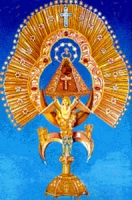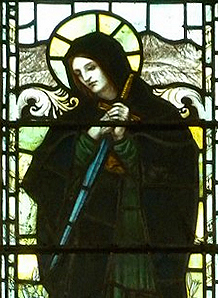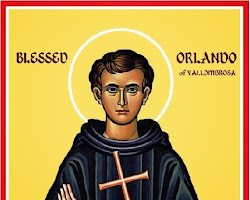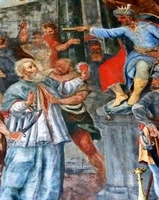Saint Lydia Purpuraria
புனித லீதிரா
பிலிப்பியின்(இன்றைய கிரேக்கத்தின்) முதல் கிறித்தவர்
பிறப்பு
முதல் நூற்றாண்டு
தியத்திரா (அக்-ஈசார்), ஆசியா மைனர் Thyatira (Ak-Hissar), Asia minor
இறப்பு
முதல் அல்லது இரண்டாம் நூற்றாண்டு
பாதுகாவல்: சாயத்தொழில் (Patronin der Färber)
திருத்தூதர் பவுலால் மனமாற்றம் செய்யப்பட்ட முதல் பெண் இவர். திருத்தூதர் பவுல் இவரின் வீட்டிலேயே தங்கி இவருக்கு திருமுழுக்கு கொடுத்தார். இவர் பிலிப்பி (Philippi) என்ற நகரில் மனமாற்றம் அடைந்தார். இவரைப்பற்றி திருத்தூதர்பணி 16:14-15-ல் விளக்குகிறது. உரோமையரின் குடியேற்ற நகரமான பிலிப்பியில் பவுல் சில நாள்கள் தங்கியிருக்கும் வேளையில் ஓய்வுநாளன்று நகர வாயிலுக்கு வெளியே வந்து ஆற்றங்கரை சென்றார். அங்கு இறைவேண்டல் செய்யும் இடம் ஏதேனும் இருக்கும் என்று எண்ணி அமர்ந்து, அங்கே கூடியிருந்த பெண்களோடு பேசினார். அங்கு தியத்திரா நகரை சேர்ந்த பெண் ஒருவர் நாங்கள் பேசியதை கேட்டு கொண்டிருந்தார். அவர் பெயர் லீதியா. செந்நிற ஆடைகளை விற்பவரான அவர் கடவுளை வழிபட்டு வந்தார். பவுல் பேசியதை ஏற்றுக்கொள்ளுமாறு ஆண்டவர் அவர் உள்ளத்தை திறந்தார். அவரும், அவர் வீட்டாரும் திருமுழுக்கு பெற்றனர். அதன்பின் அவர் எங்களிடம், "நான் ஆண்டவரிடம் நம்பிக்கை கொண்டவள் என்று நீங்கள் கருதினால் என் வீட்டுக்கு வந்து தங்குங்கள்" என்று கெஞ்சிக்கேட்டு எங்களை இணங்கவைத்தார்
Saint Lydia Purpuraria was a 1st-century Christian convert and a seller of purple cloth. Her feast day is celebrated on August 3 in the Catholic Church and on May 20 in the Eastern Orthodox Church.
She was a native of Thyatira, a city in Asia Minor (modern Turkey). She was a wealthy woman who owned a business selling purple cloth. Purple was a very expensive dye, and it was only used by the wealthy.
Lydia was converted to Christianity by Saint Paul during his first missionary journey. She was baptized in Philippi, and she became a leader in the early Christian community there. She opened her home to the Christian community, and it became a place where they could meet and worship.
Lydia is mentioned in the Book of Acts, and she is one of the few women mentioned by name in the Bible. She is a role model for all Christians, and she is an inspiration to all who know her story.
Saint Waltheof of Melrose
Also known as
Waldef, Walden, Waldeve, Walene, Wallevus, Walthen
Profile
Born to the English nobility, the second son of Simon, Earl of Huntingdon, and Maud (Matilda), grand-niece of William the Conqueror. Grandson of Saint Waldef of Northumbria. Even as a child, Waltheof felt drawn to churches, and later to the religious life. Following his father's death, he, his mother and his brother moved to Scotland where Maud married King David I. Part of David's court where he was educated and became a spiritual student of Saint Aelred of Rievaulx, master of the royal household. Deciding on a religious life, Waltheof left Scotland.
Augustinian canon at Nostelle Monastery, Yorkshire, England c.1130. Abbot of Kirkham, England in 1134. Chosen archbishop of York, England in 1140, but King Stephen opposed Waltheof's connections with and sympathy toward Scotland, and prevented the appointment.
Cistercian monk at Wardon, Bedforshire, England; he tried to bring along some of his brothers, but failed. Abbot of Melrose Abbey in 1149. Acquainted with Saint Malachy O'More, and helped him in his travels. With his step-father, King David, he helped found monasteries at Cultram and Kinross. Named archbishop of Saint Andrews, Scotland in 1154, but felt inadequate; he convinced Saint Aelred of his desire to avoid the see, and Aelred publicly opposed the appointment.
Noted for his severe, self-imposed austerities, endless kindness to the poor, and a gentle hand with the brothers under his supervision. Received visions of Christ during the feasts of Christmas, Passiontide, and Easter; had visions of heaven and hell. Miracle worker who is reported to have multiplied food, and miraculously healed the sick, especially the blind.
Born
c.1100 in England
Died
• 3 August 1160 of natural causes
• buried at the Cistercian chapter house at Melrose Abbey
• body found incorrupt in 1207, but when moved again in 1240, it had decayed
Blessed Federico López y López
Also known as
• Alfonso López y López
• Brother Alfonso
• Father Alfonso
Profile
Worked at a number of jobs and positions as a young adult, all the while feeling a call to religious life. In 1906 he finally said yes, and joined the Franciscan Friars Minor Conventual at their convent in Granollers, Spain. Studied at the Franciscan seminary in Granollers, and then in Osimo, Italy where he made his solemn profession in 1911, taking the name Alfonso. Ordained a priest in 1911. Apostolic penitentiary confessor at the Shrine of Loreto from 1912 to 1915. Teacher, spiritual director and novice master at the Ganollers convent from 1915 to 1936; one of his novices was Blessed Eugenio Remón Salvador who died with him. Had a great devotion to the Blessed Virgin Mary, and was known as a great example to and leader of novices. Martyred in the Spanish Civil War.
Born
16 November 1878 in Secorum, Huesca, Spain
Died
shot in the evening of 3 August 1936 in Samalús, Barcelona, Spain
Beatified
11 March 2001 by Pope John Paul II
Saint Gamaliel
Profile
First century Jewish Talmudic scholar. Teacher of Saint Paul the Apostle. In Acts 5:34-39 we read that his counsel saved Saint Peter and Saint John. An ancient tradition says he converted to Christianity, but there is no proof of this.
Blessed Augustine Gazotich
Also known as
• Augustin Kazotic
• Augustine Kazotic
Profile
Joined the Domnicans at age 29. Missionary to the Slavs and Hungarians. Bishop of Zagreb, Croatia in 1303. Bishop of Luccera, Italy. Had the gift of healing.
Born
1262 at Trau, Dalmatia
Died
3 August 1323 at Lucera, Foggia, Italy of natural causes
Beatified
• 17 July 1700 by Pope Leo X (cultus confirmed)
• Pope Innocent XII (cultus confirmed)
Blessed Francisco Bandrés S´nchez
Profile
Studied at Huesca and Campello, Spain. Joined the Salesians of Don Bosco in 1913, beginning his novitiate at Carabanchel in Barcelona, Spain. Ordained a priest in 1922. Musician and musical director. Taught in Barcelona, Mataro and Sarria. At the start of the Spanish Civil War, he used the school resources to send away as many of the students and his Salesians brothers as possible. Martyred by members of the Unified Marxist Workers Party for the crime of being a priest and running a Catholic school.
Born
24 April 1896 in Hecho, Huesca, Spain
Died
tortured to death on 3 August 1936 in a prison cell at the headquarters of the Unified Marxist Workers Party in Barcelona, Spain
Beatified
11 March 2001 by Pope John Paul II
Blessed Eugenio Remón Salvador
Also known as
• Miguel Remón Salvador
• Brother Miguel
Profile
Eugenio joined the Franciscan Friars Minor Conventual at the convent in Granollers, Spain in 1925 where he took the name Miguel, and served his novitiate under the guidance of Blessed Federico López y López; he made his perpetual profession in Loreto, Italy in 1933 where he spent two years in work and study at the basilica before returning to Granollers. Martyred in the Spanish Civil War.
Born
7 September 1907 in Caudé, Teruel, Spain
Died
shot in the evening of 3 August 1936 in Samalús, Barcelona, Spain
Beatified
11 March 2001 by Pope John Paul II
Blessed Benno of Metz
Also known as
Benno of Einsiedeln
Profile
Born to the nobility. Canon in Strasbourg, France. Hermit on Mount Etzel in Switzerland in 906, living in the former hermitage of Saint Meinrad. Benno's reputation for holiness spread, spiritual students gathered around him, and in 924 he founded the Benedictine monastery of Einsiedeln for them. Bishop of Metz, France in 927. Because he was chosen over a local favourite, and because he worked to reform the diocese, he made enemies; in 929 he was attacked and blinded. Soon after, he retired and returned to Einsiedeln Abbey where he lived the rest of his days as a prayerful monk.
Born
late 9th century in Swabia (part of modern Germany)
Died
• 3 August 940 in Einsiedeln, Switzerland of natural causes
• relics in Einsiedeln Abbey
Saint Anthony the Roman
Profile
Raised in a pious family during the time of the Great Schism; Anthony's loyalties lay with the Orthodox Church. He gave away his goods, and became a hermit monk. Lived on a rock surrounded by the sea for fourteen months. The rock then broke loose and floated across the waters to Novgorod in Rus. Archbishop Nikita welcomed Anthony as a holy man, and helped him build a church dedicated to the Blessed Virgin Mary. Anthony attracted students, a monastery grew up around the church, and Anthony served as its abbot. Miracle worker.
Born
1086 in Rome, Italy
Died
1148 in Novgorod, Russia of natural causes
Blessed Jose Guardiet y Pujol
Profile
Priest of the archdiocese of Barcelona, Spain. Rector of the parish of San Pedro in Rubi, Spain, he organized pilgrimages, supported education, and worked to make the church a hub of life for his parishioners. Had a great devotion to Our Lady of Monserrat. Imprisoned and executed for the crime of priesthood in the Spanish Civil War.
Born
21 June 1879 in Manlleu, Barcelona, Spain
Died
shot by firing squad on 3 August 1936 on the L'Arrabassada highway, Barcelona, Spain
Beatified
13 October 2013 by Pope Francis
Blessed Salvador Ferrandis Seguí
Profile
Studied at the Colegio del Patriarca. Ordained as a priest in the archdiocese of Valencia, Spain in 1904. Parish priest in L'Alqueria de Comtessa, and then Pedreguer, Spain. Used his personal and family funds to re-build the church, and to support the poor and sick. Martyred in the Spanish Civil War for the crime of being a priest.
Born
25 May 1880 in L'Orxa, Alicante, Spain
Died
shot on 3 August 1936 on the Vergel highway, Alicante, Spain
Beatified
11 March 2001 by Pope John Paul II
Saint Euphronius of Autun
Also known as
• Euphromius
• Eufronio
Profile
Friend of Saint Lupus of Troyes. Bishop of Autun, France. Founded the first monastery in the diocese, the priory of Saint Symphorian. Attended the Council of Arles in 475. Fought the Arian and Pelagian heresies in his diocese. Built a basilica over the tomb of Saint Symphorian, and improved the tomb of Saint Martin of Tours. Praised by leaders of his time for his lack of favoritism as he appointed the best people to the job without concern for their connections.
Died
late 5th century of natural causes
Blessed Ricardo Gil Barcelón
Profile
One of ten children born to Francesco and Francesca Gil Barcelon. Soldier in the Philippines during the Spanish-American war. Priest in the Archdiocese of Valencia, Spain, ordained on 24 September 1904. Member of the Sons of Divine Providence. Martyred in the Spanish Civil War.
Born
27 October 1873 in Manzanera, Teruel, Spain
Died
3 August 1936 in El Saler, Valencia, Spain
Beatified
27 October 2013 by Pope Francis
Saint Senach of Clonard
Also known as
Snach
Additional Memorial
6 January as one of the Twelve Apostles of Ireland
Profile
Educated at the School of Clonard in Ireland. Spiritual student of Saint Finnian of Clonard. Extreme ascetic who lived a life of penance and self-denial. Often assigned to shepherd seminarians at Clonard, which included Saint Columba of Terryglass. Succeeded Finnian as abbot of Clonard. Bishop.
Died
6th century
Saint Aspren of Naples
Also known as
Asprenato, Aspronas, Aspremo
Profile
Convert, brought to the faith by Saint Candida the Elder. Knew Saint Peter the Apostle, and one story says he was healed by him. First bishop of Naples, Italy, and devoted himself to evangelization.
Patronage
archdiocese of Naples, Italy
Blessed Godfrey of Le Mans
Profile
Bishop of Le Mans, France in 1234. Founded the Charterhouse of Parc d'Orgues, France.
Died
• 1255 at Anagni, Italy of natural causes
• buried at Parc d'Orgues, France
Saint Abibas
Also known as
Abibo, Habib
Profile
Born Jewish, the second son of Gamaliel, a member of the Sanhedrin, and a teacher of Saint Paul the Apostle. Convert to Christianity.
Saint Dalmatius
Profile
Archimandrite. A staunch defender of Christianity, especially against Nestorianism. Especially venerated in Constantinople.
Died
c.440 of natural causes
Saint Trea of Ardtree
Profile
Adult convert, brought to the faith by Saint Patrick. Anchoress at Ardtree, Derry, Ireland.
She is a fifth-century Irish saint, also known as Trea of Maghera, who is the patron saint of the parish of Ardtrea in County Derry, Northern Ireland.
According to the 9th-century Tripartite Life of St. Patrick, Trea was one of the women who received the veil from St. Patrick himself. She is said to have lived as a hermit in Ardtrea, where she died and was buried.
Died
5th century
Blessed Gregory of Nonantula
Gregory was born in Nonantula, Italy, in the year 903. He entered the Benedictine monastery at Nonantula at a young age and was ordained a priest. He became abbot of the monastery in 942 and served in that position for 28 years.
Gregory died in Nonantula in 972. His feast day is celebrated on August 3.
Saint Gaudentia
She was a virgin martyr who was killed during the persecution of Christians under the Roman Emperor Diocletian.
Gaudentia was born in Rome in the early 4th century. She was a devout Christian and refused to renounce her faith, even when she was tortured and threatened with death. She was eventually beheaded, and her body was thrown into the Tiber River.
Saint Hermellus
Saint Hermellus is commemorated on August 3 in the Catholic Church and the Eastern Orthodox Church. He was a 4th-century martyr who was killed during the persecution of Christians under the Roman Emperor Diocletian.
Hermellus was born in Massilia (modern-day Marseille, France) in the early 4th century. He was a devout Christian and refused to renounce his faith, even when he was tortured and threatened with death. He was eventually beheaded, and his body was thrown into the sea.
Martyred in the Spanish Civil War
Thousands of people were murdered in the anti-Catholic persecutions of the Spanish Civil War from 1934 to 1939.
• Blessed Andrés Avelino Gutiérrez Moral
• Blessed Antonio Isidoro Arrué Peiró
• Blessed Eleuterio Mancho López
• Eugenio Remón Salvador
• Federico López y López
• Francisco Bandrés S´nchez
• Blessed Geronimo Limón Márquez
• Jose Guardiet y Pujol
• Blessed Patricio Beobide Cendoya
• Ricardo Gil Barcelón
• Salvador Ferrandis Seguí
Martyrs of Vercelli
The Martyrs of Vercelli were a group of Christian martyrs who were killed in Vercelli, Italy, during the Diocletianic Persecution. They were executed on August 3, 304.
Martin of Carinola
Martin of Carinola was an Italian monk and bishop who lived during the 11th century. He is venerated as a saint by the Catholic Church.
Martin was born in Carinola, Italy, in the year 1006. He entered the Benedictine monastery at Montecassino at a young age and was ordained a priest. He became abbot of the monastery in 1053 and served in that position for 20 years.
Martin died in Montecassino in 1073. His feast day is celebrated on August 3.
Peter of Anagni
அனாக்னி நகர்ப் புனித பேதுரு (1030-1109)
இவர் இத்தாலியில் உள்ள சலர்னோ என்ற நகரில் பிறந்தவர்.
சிறு வயதிலேயே இறைவன்மீது மிகுந்த பற்றுகொண்ட இவர், வளர்ந்து பெரியவரானபோது, புனித பெனடிக்ட் சபையில் சேர்ந்து துறவியானார்.
இவரிடருந்த ஞானத்தையும் அறிவாற்றலையும் திறமையையும் கண்டு வியந்துபோன, திருத்தந்தை ஏழாம் கிரகோரி இவரை அனாக்னி ன்ற நகரின் ஆயராகத் திருநிலைப்படுத்தினார்.
இவர் ஆயராக உயர்ந்த பிறகு, தன் மறைமாவட்டத்திலிருந்த மக்களுடைய ஆன்மிக வாழ்வில் மிகப்பெரிய மாற்றத்தை கொண்டுவந்தார்; அவர்களுக்கென பெருங்கோயில் (Cathedral) ஒன்றையும் கட்டித் தந்தார்.
இப்படி மிகச் சிறப்பான பணிகளைச் செய்து வந்த இவரை, இரண்டாம் அர்பன் என்ற திருத்தந்தை தன்னுடைய பிரதிநிதியாக ஏற்படுத்தினார். இவருடைய காலத்தில் புனித நாடுகளுக்கு ஆபத்து வந்தபோது, அவற்றை எப்படிப் பாதுகாக்கலாம் என்பதற்கு இவர் நல்ல முறையில் ஆலோசனைகளை வழங்கினார்.
இவ்வாறு மக்களுடைய ஆன்மிக வாழ்வில் மிகப்பெரிய எழுச்சியை ஏற்படுத்தி, நல்ல ஆலோசகராகச் செயல்பட்டு வந்த இவர் 1109 ஆம் ஆண்டு இறையடி சேர்ந்தார். இவருக்கு இரண்டாம் பாஸ்கல் என்ற திருத்தந்தை, இவர் இறந்த நான்காம் ஆண்டிலேயே புனிதர் பட்டம் வழங்கினார்
Peter of Anagni (died 3 August 1105) was a Benedictine monk, bishop and papal legate.
Born in Salerno, he entered the Benedictines and so distinguished himself as a monk that Pope Gregory VII appointed him Bishop of Anagni.As bishop, he improved the spiritual welfare of the city and started rebuilding the city's cathedral. He was then sent as papal legate to the Byzantine Empire where he was able to convince Emperor Michael VII Doukas to provide funds and craftsmen to building of the cathedral.[3][4] The new cathedral also included a hospital where, contrary to modern hospitals, accommodation and care was provided for free not only to the sick but also to travellers.[2] Peter joined in 1096 the forces of Bohemond of Taranto[4] during the First Crusade on their way to the Holy Land and later returned by way of Constantinople, Palermo and Salerno.[5]
Peter died on 3 August 1105.[5] He was canonized in 1109 by Pope Paschal II, a mere four years after his death.[6] His feast is on 3 August
















































